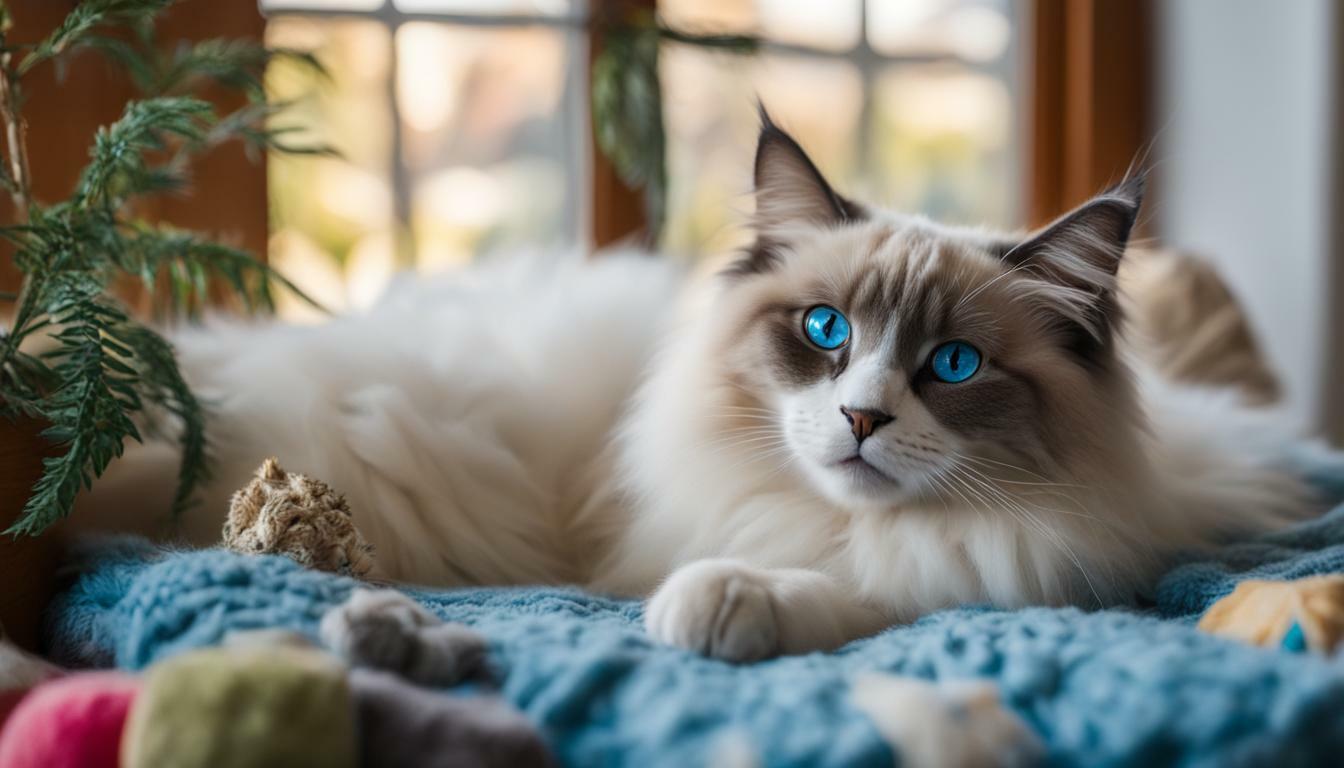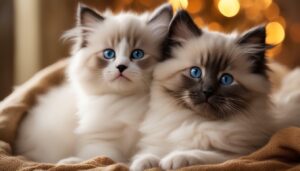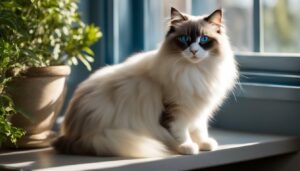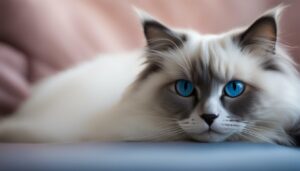Welcome to the world of Ragdoll cats! If you’re curious about this unique breed, you’ve come to the right place. The Ragdoll is a breed of cat known for its distinct colorpoint coat, blue eyes, and large size. Developed in the 1960s by American breeder Ann Baker in California, Ragdolls are best known for their docile temperament and affectionate nature. They are often referred to as “dog-like cats” due to their tendency to follow people around and their friendly behavior towards other pets. Ragdolls have upside-down V-shaped markings on their foreheads, large round blue eyes, and a soft and silky coat. They come in various colors and patterns, including seal, chocolate, blue, lilac, and cream. The breed is recognized by major cat registries such as the CFA and the TICA. Ragdolls are social cats that enjoy interactive play and snuggling. They are generally easy to care for but require regular grooming to maintain their coat. The breed is prone to certain health issues such as hypertrophic cardiomyopathy and urinary tract problems. Ragdolls have a lifespan of 13 to 18 years and are considered a popular breed among cat enthusiasts.
Key Takeaways:
- Ragdolls are known for their distinct colorpoint coat, blue eyes, and large size
- The breed was developed by American breeder Ann Baker in the 1960s
- Ragdolls have a docile temperament and are often described as “dog-like cats”
- They have upside-down V-shaped markings on their foreheads and a soft, silky coat
- Ragdolls come in various colors and patterns, recognized by major cat registries
Ragdoll cat characteristics
Ragdoll cats boast some truly special qualities that set them apart from other feline breeds. Their docile temperament and affectionate nature make them ideal companions for families and individuals alike. These “dog-like cats” are known for their unconditional love and loyalty, often following their owners from room to room and greeting them at the door. The Ragdoll’s friendly demeanor extends to other pets as well, making them great additions to multi-pet households.
One of the most captivating features of Ragdolls is their stunning appearance. With their large, round blue eyes and upside-down V-shaped markings on their foreheads, they have a regal and majestic look. Their colorpoint coat comes in a variety of colors and patterns, including seal, chocolate, blue, lilac, and cream. The soft and silky texture of their fur adds to their overall charm.
When it comes to playtime, Ragdolls exhibit a playful and interactive nature. They enjoy interactive toys and games that stimulate their minds and keep them entertained. However, they are equally content snuggling up with their human companions for a relaxing cuddle session. Their laid-back personality makes them adaptable to various living environments, including apartments and homes with or without children.
Ragdoll cat personality
The Ragdoll cat’s personality is as special as its physical attributes. They are known for their gentle disposition and patient nature, making them wonderful companions for children. Ragdolls are tolerant of handling and are not easily provoked, which is why they are often included in the list of child-friendly cat breeds.
These affectionate cats crave attention and human interaction. They love to be involved in their owner’s activities and will often provide companionship during daily routines. Ragdolls are not independent cats and do not appreciate being left alone for long periods. They thrive in a loving and interactive environment where they can receive the attention they desire.
“Ragdolls are the ultimate lap cats. They have an extraordinary ability to relax their bodies, often going limp like a ragdoll when picked up or held,” says renowned feline behaviorist, Dr. Emily Stevens. “Their calm and easy-going nature make them perfect for households seeking a loving and low-maintenance pet.”
In conclusion, Ragdoll cats possess a unique combination of physical and personality traits that make them highly sought-after pets. Their stunning appearance, docile temperament, and affectionate nature contribute to their popularity among cat enthusiasts. Whether you are looking for a loving companion or a family pet, the Ragdoll cat is sure to bring joy, warmth, and endless cuddles into your life.
Ragdoll Cat Care
Taking care of a Ragdoll cat requires some specific considerations to keep them healthy and happy. These beautiful feline companions have unique needs that cat owners should be aware of. Here are some essential tips to help you provide the best care for your Ragdoll cat:
- Grooming: Ragdolls have long, soft fur that requires regular grooming to prevent matting and keep their coat in good condition. Brush their fur at least once a week to remove loose hair and prevent tangles. Pay special attention to their undercoat and their beautiful plumed tail. Regular grooming will also help reduce shedding.
- Feeding: Provide a balanced diet that meets the nutritional needs of your Ragdoll cat. High-quality cat food specifically formulated for their age and activity level is recommended. Avoid overfeeding, as Ragdolls are prone to obesity. Consult your veterinarian for guidance on portion sizes and feeding frequency.
- Exercise: Despite their large size, Ragdolls are not particularly active cats. However, they still require regular exercise to maintain a healthy weight and prevent boredom. Engage in interactive play sessions using toys that stimulate their natural hunting instincts. Provide scratching posts and climbing structures to keep them physically and mentally stimulated.
Preventive Healthcare
Ragdolls are generally healthy cats, but they are prone to certain health issues that require special attention:
- Hypertrophic Cardiomyopathy (HCM): This is a genetic heart condition that affects Ragdolls. Regular veterinary check-ups and screenings are essential to monitor their heart health. Be aware of symptoms such as lethargy, difficulty breathing, or fainting, and seek immediate veterinary care if you notice any abnormal behavior.
- Urinary Tract Problems: Ragdolls are susceptible to urinary tract issues, including bladder stones and infections. Ensure they have access to fresh water at all times and provide a balanced diet that promotes urinary health. If you notice any signs of discomfort or changes in their litter box habits, consult your veterinarian.
Remember, Ragdolls are social cats that thrive on human interaction and companionship. They enjoy being part of the family and do best in homes where they receive plenty of attention and love. With proper care and attention to their specific needs, your Ragdoll cat will bring joy and happiness to your home for many years to come.
| Ragdoll Cat Care Tips | |
|---|---|
| Grooming | Regular brushing to prevent matting and reduce shedding |
| Feeding | Provide a balanced diet, avoid overfeeding, consult your vet for guidance |
| Exercise | Engage in interactive play sessions and provide climbing structures |
| Preventive Healthcare | Regular vet check-ups, monitor heart health and urinary tract |
Ragdoll Cat History
To truly appreciate the Ragdoll cat, it’s important to understand its intriguing history and how it came to be. Developed in the 1960s by American breeder Ann Baker in California, the Ragdoll breed has a fascinating origin story.
Ann bred a white domestic long-haired female cat named Josephine with various male cats, including a Birman and a Persian. The result was a unique cat with a gentle and docile temperament, large size, and stunning colorpoint coat. Ann named this new breed “Ragdoll” because of their tendency to relax and go limp when picked up, similar to a child’s ragdoll toy.
The Ragdoll breed quickly gained popularity, and Ann established the International Ragdoll Cat Association (IRCA) to promote and protect the breed. However, Ann’s controversial breeding practices and disagreements with other breeders led to the formation of other Ragdoll cat associations, such as the Ragdoll Fanciers Worldwide Club (RFC) and Ragdoll Breed Club (RBC).
| Key Events | Year |
|---|---|
| Ann Baker develops the Ragdoll breed | 1960s |
| The International Ragdoll Cat Association (IRCA) is established | 1967 |
| Formation of other Ragdoll cat associations | 1970s |
The Ragdoll breed quickly gained popularity, and Ann established the International Ragdoll Cat Association (IRCA) to promote and protect the breed. However, Ann’s controversial breeding practices and disagreements with other breeders led to the formation of other Ragdoll cat associations.
Today, the Ragdoll breed is recognized and admired by cat enthusiasts worldwide. Their friendly and relaxed demeanor, combined with their striking appearance, makes them a sought-after breed. Whether you’re looking for a loyal companion or a beautiful addition to your family, the Ragdoll cat is sure to captivate your heart.
Interesting facts about Ragdoll cats:
- Ragdolls are known for their exceptional tolerance to being handled, making them great pets for families with children.
- They have a slow maturation process, with full coat and color development taking up to four years.
- The breed’s large size makes them one of the heaviest domestic cat breeds, with males weighing between 15 to 20 pounds.
- Ragdolls are not fully independent cats and thrive in environments where they receive plenty of love and attention.
Now that you know the captivating history of the Ragdoll cat, you can better understand why they are cherished by cat lovers worldwide. From their unique appearance to their gentle and affectionate nature, Ragdolls truly embody the essence of a perfect feline companion.
Ragdoll Cat Breeders and Adoption
If you’re thinking of adding a Ragdoll cat to your household, there are a few options to consider, whether you choose to adopt or purchase from a breeder. When it comes to finding reputable Ragdoll cat breeders, it is essential to do your research and ensure that you are getting your new furry friend from a trustworthy source. Look for breeders who prioritize the health and well-being of their cats, follow responsible breeding practices, and are registered with reputable cat associations.
Adopting a Ragdoll cat can be a wonderful way to provide a loving home to a cat in need. Many animal shelters and rescue organizations have Ragdoll cats available for adoption. By adopting, you not only give a deserving cat a second chance at a loving home but also contribute to reducing the number of cats in shelters. Adoption fees often include spaying/neutering, vaccinations, and microchipping, making it a cost-effective option.
When adopting or purchasing a Ragdoll cat, it’s important to consider the cat’s temperament, health history, and whether they will be a good fit for your lifestyle and household. Ragdolls are known for their friendly and affectionate nature, so be sure to spend time interacting with the cat before making a decision.
Remember, owning a Ragdoll cat comes with responsibilities, such as providing proper care, including regular grooming and veterinary check-ups. Creating a safe and stimulating environment for your cat is also crucial for their overall well-being.
In summary, whether you decide to adopt a Ragdoll cat from a shelter or purchase one from a reputable breeder, it’s important to choose the option that aligns with your values and preferences. Ragdolls make wonderful companions and are sure to bring joy and love into your home. With their striking appearance and gentle temperament, they are truly a remarkable breed.
Ragdoll Cat Breeders and Adoption:
| Breeders | Contact Information |
|---|---|
| Happy Paws Ragdolls | Phone: (555) 123-4567 Email: info@happypawsragdolls.com |
| Whiskers and Cuddles Cattery | Phone: (555) 987-6543 Email: whiskersandcuddles@gmail.com |
| Rescue Organizations | Website: www.rescuecats.org Phone: (555) 555-5555 |
Conclusion
Ragdoll cats are truly a breed like no other, with their gentle nature, striking appearance, and loving disposition, making them a wonderful choice for both experienced cat owners and newcomers alike.
With their distinct colorpoint coat, blue eyes, and large size, Ragdolls are instantly recognizable. Developed in the 1960s by American breeder Ann Baker in California, these cats have gained popularity for their docile temperament and affectionate nature. Often referred to as “dog-like cats,” Ragdolls have a tendency to follow people around and exhibit friendly behavior towards other pets.
One of the standout features of Ragdolls is their upside-down V-shaped markings on their foreheads, which complement their large round blue eyes. Their soft and silky coat comes in a variety of colors and patterns, including seal, chocolate, blue, lilac, and cream. As a breed recognized by major cat registries such as the CFA and the TICA, Ragdolls are highly sought after by cat enthusiasts.
Ragdolls thrive on social interaction and enjoy both interactive play and snuggling. While they are generally easy to care for, regular grooming is essential to maintain their coat’s beauty and prevent matting. It’s important to note that Ragdolls are prone to certain health issues, such as hypertrophic cardiomyopathy and urinary tract problems. However, with proper care and regular vet check-ups, Ragdolls can live a long and healthy life, with a lifespan ranging from 13 to 18 years.
Whether you’re looking to add a Ragdoll kitten to your family or considering adopting an adult Ragdoll, you can find reputable breeders or rescues that specialize in this breed. Ragdoll cats make wonderful companions, bringing joy and love to any household. So, if you’re searching for a cat that combines beauty, affection, and a gentle nature, look no further than the Ragdoll breed.
FAQ
Q: What is a Ragdoll cat?
A: A Ragdoll cat is a breed known for its distinct colorpoint coat, blue eyes, and large size. They are best known for their docile temperament and affectionate nature.
Q: Are Ragdoll cats good with other pets?
A: Yes, Ragdoll cats are known for their friendly behavior towards other pets, making them a great addition to multi-pet households.
Q: What colors and patterns do Ragdoll cats come in?
A: Ragdoll cats come in various colors and patterns, including seal, chocolate, blue, lilac, and cream.
Q: Do Ragdoll cats require a lot of grooming?
A: Ragdoll cats have a soft and silky coat that requires regular grooming to maintain its beauty. Regular brushing and occasional bathing are recommended.
Q: What are some common health issues in Ragdoll cats?
A: Ragdoll cats can be prone to health issues such as hypertrophic cardiomyopathy (a heart condition) and urinary tract problems. Regular vet check-ups are important to monitor their health.
Q: What is the lifespan of a Ragdoll cat?
A: Ragdoll cats have a lifespan of 13 to 18 years, depending on their overall health and care.
Q: Are Ragdoll cats good with children?
A: Ragdoll cats are known for their docile temperament, making them generally good with children. However, it’s important to teach children how to properly handle and interact with cats to ensure everyone’s safety.
Q: How can I find a reputable Ragdoll cat breeder?
A: To find a reputable Ragdoll cat breeder, it’s recommended to do thorough research, ask for references, and visit the breeder in person to assess the living conditions of the cats.
Q: Can I adopt a Ragdoll cat?
A: Yes, there are often Ragdoll cats available for adoption. Contact local animal shelters, rescue organizations, or Ragdoll-specific rescue groups to inquire about adoption opportunities.
Q: Are Ragdoll cats hypoallergenic?
A: While no cat breed is completely hypoallergenic, Ragdoll cats are known to produce fewer allergenic proteins compared to some other breeds. However, individual allergies can vary, so it’s recommended to spend time with a Ragdoll cat before bringing one home if allergies are a concern.



